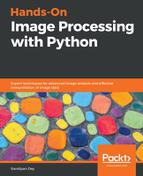Chapter 1, Getting Started with Image Processing, covers image processing and its applications, different Python libraries, image input/output, data structures, file formats, and basic image manipulations.
Chapter 2, Sampling, Fourier Transform, and Convolution, covers 2D Fourier transform, sampling, quantization, discrete Fourier transform, 1D and 2D convolution and filtering in the frequency domain, and how to implement them with Python using examples. You will learn the simple signal processing tools that are needed in order to understand the following units.
Chapter 3, Convolution and Frequency Domain Filtering, demonstrates how convolution is carried out on images using Python. Topics such as filtering in the frequency domain are also covered.
Chapter 4, Image Enhancement, covers some of the most basic tools in image processing, such as mean/median filtering and histogram equalization, which are still among the most powerful. We will describe these and provide a modern interpretation of these basic tools.
Chapter 5, Image Enhancement using Derivatives, covers further topics associated with image enhancement, in other words, the problem of improving the appearance or usefulness of an image. Topics covered include edge detection with derivatives and Laplacian, sharpening, and pseudo coloring. All the concepts will be described with the help of examples involving Python.
Chapter 6, Morphological Image Processing, covers binary operations and the use of filter rank module to perform operations such as morphological contrast enhancements, noise removal, and computing local entropy. We will also see how a morphology module is used.
Chapter 7, Extracting Image Features and Descriptors, describes several techniques for extracting features from images/compute image descriptors.
Chapter 8, Image Segmentation, outlines the basic techniques for partitioning an image, from a simple threshold to more advanced graph cuts.
Chapter 9, Classical Machine Learning Methods in Image Processing, introduces a number of different machine learning techniques for image classification and object detection/recognition.
Chapter 10, Deep Learning in Image Processing – Image Classification, describes why the image processing/computer vision community gradually transitioned from the classical feature-based machine learning models to deep learning models.
Chapter 11, Deep Learning in Image Processing - Object Detection, and more, describes a number of remarkable applications of the CNNs for object detection, semantic segmentation, and image style transfer. A few popular models, such as YOLO and object proposals, will be demonstrated. How to use transfer learning to avoid learning a very deep neural net from scratch will also be outlined.
Chapter 12, Additional Problems in Image Processing, describes a number of additional image processing problems and various algorithms for solving them. Problems include seam carving (for context-aware image resizing), image quilting (for image resizing with non-parametric sampling and texture transfer), poisson (gradient) image editing (blending) to seamlessly blend one image within another, image morphing (to transform one image to another), image inpainting (to restore a degraded image), and some variational image processing techniques (for image denoising, for example).
